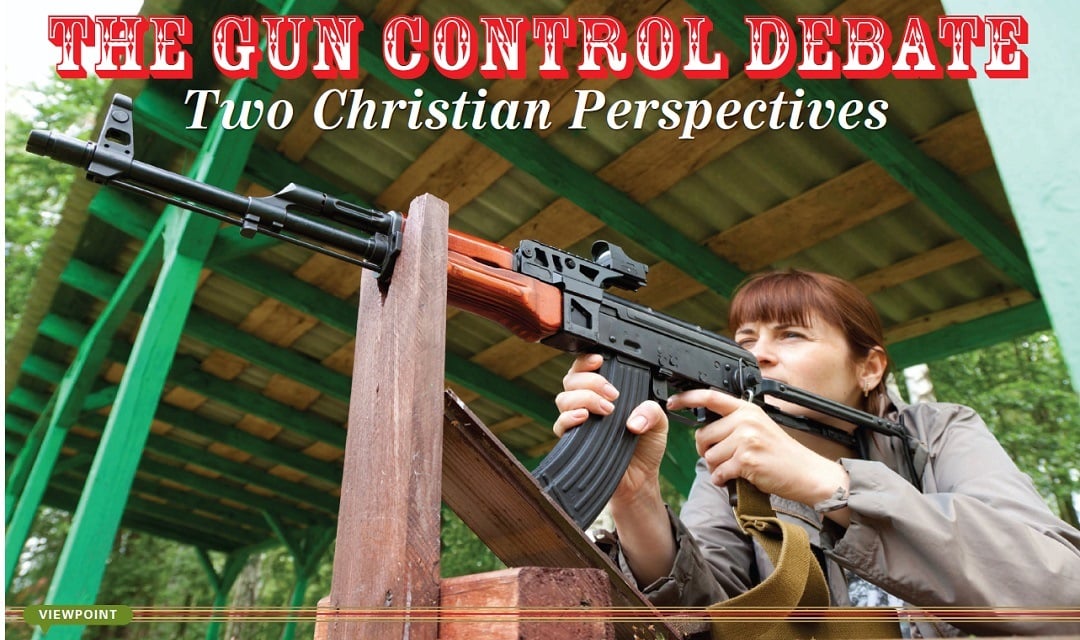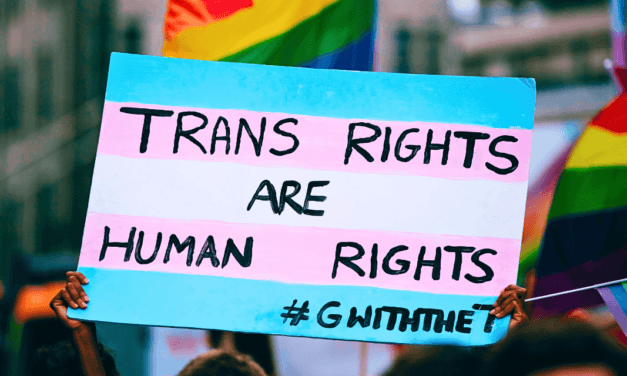This article first appeared in Christian Research Journal, volume 36, number 06 (2013). The full text of this article in PDF format can be obtained by clicking here. For further information or to subscribe to the CHRISTIAN RESEARCH JOURNAL go to: http://www.equip.org/christian-research-journal/
Sandy Hook school. The Washington Navy Yard. The Aurora theater. The Sikh temple. Mass murders such as these have been shaking the national composure with alarming regularity, and such random shootings only begin to tell the story of gun-related violence in America. Should current gun laws be strengthened or does the solution lie elsewhere? In this debate, two thoughtful Christians offer differing perspectives on what Scripture, the Second Amendment and the statistics have to say.
Why I Support Stricter Gun Laws
by Michael W. Austin
Some estimate that there are currently more than 300 million guns in the United States, or roughly one per person. In the United States, eighty-five people per day are killed by guns, and more than twice that are injured.1 No law can eliminate all deaths and injuries by guns, but a case can be made that stricter laws would reduce the number of them that occur. Given the role of guns in American society, their connections with violent crime (especially domestic crime), and the flaws in the current regulation of firearms, there are good reasons for more strictly limiting access to guns in the United States. Moreover, Christians have good biblical, theological, and philosophical reasons for favoring stricter gun laws.
THE SECOND AMENDMENT
The Second Amendment to the U.S. Constitution reads, “A well regulated Militia, being necessary to the security of a free State, the right of the people to keep and bear Arms, shall not be infringed.” Mass shootings at Virginia Tech, Aurora, and Newtown, as well as the shooting death of Trayvon Martin, have reignited debate concerning gun laws in the United States. Some argue that the Second Amendment secures a legal right for private citizens to own firearms for many reasons, including self-defense. Others claim that when the context of the amendment is taken into account, the right it secures instead has to do with the need to have an armed militia to protect the young nation from external and internal threats, given that there was no strong professional army at the time. Still others argue that one purpose of the Second Amendment is to enable citizens to protect themselves from potential tyranny from their own government, though it is difficult to see how the need for and practicality of armed revolt would arise in the United States today, given our democratic institutions and the military might of the state.
The proper interpretation and application of the Second Amendment are not yet fully settled.2 What about Scripture and Christian theology? How might they relate to this issue?
THE NATURE OF RIGHTS
A small amount of reflection on the nature of rights will be helpful as we think about gun control and gun rights. Generally, rights are not absolute. That is, there are limits to
their scope, and one of the most significant reasons to limit the exercise of a right is that doing so will prevent serious harm to others. This is why the right to freedom of speech does not include the right to yell “Fire!” in a crowded theater. Rights are often conditional. The right to drive a car is conditional upon successfully taking written and road skills tests. The right to own a firearm is not absolute; its exercise should be dependent on the individual meeting several important conditions: a criminal and mental health background check, a required safety course, competency with a firearm demonstrated via a skills test, a regular renewal requirement, a minimum age requirement of twenty-five, and some form of gun liability insurance.3 This allows for those who are competent to own and use firearms for both sport and self-defense, and connects the right to own a firearm with the ability to properly and sensibly use it. This would make it more likely that each individual gun owner will be responsible. Another reason for this is that there is a body of evidence that provides some support for the claim that restrictive gun laws are effective.
DO RESTRICTIVE GUN LAWS WORK?
This is a complex question, and one that we should have more data about than we do at present. One reason for this lack of data is that there was essentially a freeze on federal funding for such research from the mid-1990s until January of 2013.4 As a result of this lack of federal funding for the past seventeen years, comparably little research has been done on the issue.5
Even with these spending limitations, a case can be made that such laws are part of the solution, based on the data we do possess. Consider the rate of gun murders in the United States compared to other nations.6 The rate of 3.2 per 100,000 people places the United States at twenty-sixth overall, behind countries such as Honduras (68.4), Colombia (27.1), and Mexico (10.0). However, some U.S. cities have comparable rates, such as New Orleans (62.1), Miami (23.7), and Phoenix (10.6).
A more revealing comparison is that the United States is at the top of the list of developed countries in murders per 100,000, with Switzerland’s rate of 0.8 a distant second and countries with strict gun control laws such as England and Wales (0.1) and Japan (0.0) at the other end of the list. Gun laws, once adopted, can reduce the number of firearm homicides, as was the case in both Britain and Australia.7
A study of all fifty U.S. states found that “a higher number of firearm laws in a state are associated with a lower rate of firearm fatalities in the state, overall and for suicides and homicides individually. As our study could not determine cause-and-effect relationships, further studies are necessary to define the nature of this association.”8 The lead researcher of the study, Eric Fleegler, put it this way: “In states that have the most [gun] laws, there is a 42 percent reduction in fatalities, compared to those states with the least number of laws. You can’t necessarily say one absolutely led to the other…but you can say those things are related.”9
While these statistics are important, we need more data on the connection between gun laws and overall homicide rates. It is always difficult to demonstrate a cause-and-effect relationship in such research. Nevertheless, much of the evidence we do have suggests that stricter gun laws can be part of the solution. A recent study conducted by the Harvard School of Public Health concluded that in the United States, in states where there are more guns, the overall homicide rates are also higher. In states where there are higher levels of household gun ownership, there are also higher rates of homicide.10 According to the most recent data from the United Nations Office on Drugs and Crime, the overall homicide rate in the United States, per 100,000 people, is 4.8. In nations with stricter laws, the rate is significantly less. For example, in the United Kingdom, the overall homicide rate is 1.2, in Israel it is 2.1, and in Japan it is 0.4. Other developed nations with stricter gun laws and low homicide rates include Spain (0.8), France (1.1), and Germany (0.8), among others.11
Of course, this debate is not merely statistical. Consider the Newtown mass shooting and a similar incident that happened in China on the very same day. In the central Chinese province of Henan, a man stabbed twenty-two children and one adult at a Chinese primary school. Some say this is evidence that stricter gun laws won’t prevent violent crime, and they are right. However, the crucial difference is that all of the victims in the China attack survived, whereas twenty-six people died at Sandy Hook Elementary. If the shooter in Connecticut was armed with a knife rather than a gun, many of those young victims would be alive today.12
However, it is important to note that stricter laws are not a panacea. We need to address the culture of violence and death in the United States not only legally but also at the social, individual, and spiritual levels. A crucial way to do this is with the gospel of Jesus Christ, the gospel of life that also has implications for the issue of gun control.
KINGDOM ETHICS AND THE GOSPEL OF LIFE
When applying Scripture and Christian theology to a contemporary issue such as gun control, many difficulties arise given the distance between our cultural context and that of the ancient Near East. Nevertheless, Scripture has relevant things to say concerning this and many other contemporary issues. In what follows, I start from two assumptions. First, I assume that Jesus is the exemplar for the Christian (see Phil. 3:17; 2 Peter 1:3–11; 1 John 2:6; and 3 John 11). We are to follow Him by imitating Him, by seeking to acquire and practice the moral and intellectual virtues we see in His life and teaching. My second assumption is that the ethics of the kingdom of God affirm the value of each individual human being as being made in the image of God, and because of this, Christian ethics essentially include a strong resistance to killing. As Glen Stassen and David Gushee put it in their book, Kingdom Ethics, “The kingdom of God consists of peace with justice, of life unmarred by killing.”13
First, it is clear that Scripture reveals a God whose heart is with the downtrodden (James 1:27). God longs for and works toward the realization of peace, justice, and compassion for all in our world (see Isa. 32:15–18; 4:10; 60:17–18; and Rom. 14:17). Gun violence is prominent in areas of economic struggle, and is all-too-common in cases of domestic violence against women and children. Surely these are reasons, from a Christian perspective, to limit access to guns.
Second, in both His teaching and example, Jesus is clearly and consistently antiviolence.14 In the Sermon on the Mount, a norm of nonviolent love of one’s enemies is taught (Matt. 5:38–48). Jesus forbids the use of violence for building God’s kingdom (Luke 9:51–56). His followers are to accept even the plundering of their own possessions for the sake of the gospel (Heb. 10:32–34). Romans 13 teaches that the government bears the sword to carry out God’s judgment on wrongdoers; this is not a task for individual believers. Early followers of Christ seem to have internalized His antiviolence teachings, as they did not participate in the revolt against the oppression of Rome in AD 66, which resulted in the destruction of the temple in 70. Instead, they fled Jerusalem.
As New Testament scholar Richard Hays puts it, “From Matthew to Revelation we find a consistent witness against violence and a calling to the community to follow the example of Jesus in accepting suffering rather than inflicting it.”15 Given all of this, it is hard to imagine Jesus using a gun, if one were available to Him. And as our moral, spiritual, and intellectual exemplar, we should strongly consider the implications this has for followers of Christ.
To be clear, I am not a pacifist, and the gun law position I am advocating does not require pacifism. However, the weight of the biblical evidence at least supports a fairly strong antiviolence position, stronger than the position I am defending here concerning restrictive gun laws. If I was in a situation in which I had a gun and could use it to defend perhaps myself, but certainly my family, students, or other potential victims, I think I would do so. But I would deeply regret being in a situation where the protection of innocent life seemingly required the taking of another life. I would prefer to live in a society where those who are determined to harm others have a much more difficult time obtaining firearms to carry out their immoral intentions.
Third, Christians should consider the nature of courage based on biblical and theological information. The paradigm of Christian courage is that of the martyr, rather than the action hero. Because of this, courage “can find expression as much or more in suffering and weakness as it can in striking out against a threat.”16 Such an understanding of courage will lead us to rethink the role of force in the life of the Christian who seeks to possess the courage of Christ.
In conclusion, I am not advocating strict nonviolence in every conceivable situation. I believe that violence is morally permissible in some situations. Nor am I claiming that there should be an outright ban on all firearms in the United States. These are controversial and difficult issues. However, given the strong stream of teaching against violence in Scripture, the example of Jesus, and a Christian understanding of courage, Christians should work toward the realization of nonviolence in their lives and the social structures in which they live and move as they pursue an abundant life and the common good. This includes supporting more restrictive gun laws than are currently in place.
Michael W. Austin is professor of philosophy at Eastern Kentucky University, where he specializes in ethics. His most recent book is Being Good: Christian Virtues for Everyday Life (Eerdmans, 2012).
NOTES
- Gary Younge, “America’s Deadly Devotion to Guns,” theguardian.com, April 16, 2012, http://www.guardian.co.uk/world/2012/apr/16/americas-deadly-devotion-guns.
- “Second Amendment,” Cornell University Law School, http://www.law.cornell.edu/wex/second_amendment.
- Dale Fincher, while disagreeing with my position, offered many helpful insights into this issue, including a suggested minimum age of twenty-five for owning a gun.
- Office of the Press Secretary, “Presidential Memorandum: Engaging in Public Health Research on the Causes and Prevention of Gun Violence,” whitehouse.gov, January 16, 2013, http://www.whitehouse.gov/the-press-office/2013/01/16/presidential-memorandumengaging-public-health-research-causes-and-pre-0.
- Sydney Lupkin, “CDC Ban on Gun Research Caused Lasting Damage,” ABC News, April 9, 2013, http://abcnews.go.com/Health/cdc-ban-gun-research-caused-lastingdamage/story?id=18909347#.Ud7rFqyHeSp.
- “US Gun Debate: Guns in Numbers,” BBC News, January 16, 2013, http://www.bbc.co.uk/news/world-us-canada-20759139; Richard Florida, “Gun Violence in U.S. Cities Compared to the Deadliest Nations in the World,” The Atlantic Cities, January 22, 2013, http://www.theatlanticcities.com/politics/2013/01/gun-violence-us-cities-compareddeadliest-nations-world/4412/.
- 7 “In Other Countries, Laws Are Strict and Work,” The New York Times, December 17, 2012, http://www.nytimes.com/2012/12/18/opinion/the-gun-challenge-strict-lawswork.html?_r=1&.
- Eric W. Fleegler, MD, MPH; Lois K. Lee, MD, MPH; Michael C. Monuteaux, ScD; David Hemenway, PhD; Rebekah Mannix, MD, MPH, “Firearm Legislation and Firearm Fatalities in the United States,” JAMA Internal Medicine 173, 9 (March 6, 2013): http://archinte.jamanetwork.com/article.aspx?articleid=1661390.
- Interview with Eric Fleegler, March 13, 2013, available at http://hereandnow.wbur.org/2013/03/13/gun-laws-study.
- “Homicide,” Harvard School of Public Health, http://www.hsph.harvard.edu/hicrc/firearms-research/guns-and-death/.
- For more information, see http://www.unodc.org/unodc/en/data-andanalysis/homicide.html.
- For more on this, see http://philosophybites.com/2013/02/jeff-mcmahan-on-guncontrol.html.
- Glen H. Stassen and David P. Gushee, Kingdom Ethics: Following Jesus in Contemporary Context (Downers Grove, IL: IVP Academic, 2003), 147. Much of what follows draws upon insights from this work.
- Richard B. Hays, The Moral Vision of the New Testament (New York: HarperCollins, 1996), 317–46.
- Ibid, 332.
- Rebecca Konyndyk DeYoung, “Courage,” Being Good: Christian Virtues for Everyday Life, ed. Michael W. Austin and R. Douglas Geivett (Grand Rapids: Eerdmans, 2012), 163.
To Keep and Bear Arms
A Reformed Christian Perspective on
the Second Amendment and Guns
by Ron Gleason
Many ethical issues are emotionally charged. If you want to get an argument going, just bring up abortion, euthanasia, government, the economy, and it is “game on.” We are passionate about those things we deem right or wrong, correct or incorrect, good or evil. Guns and the Second Amendment are no exceptions. Embedded in the debate about the Second Amendment and guns is yet another issue: the question of self-defense. In other words, is it biblically correct to defend ourselves and our loved ones against assailants?
If we conclude that self-defense is biblically permissible, then the next question should be: Is it ever right to use a weapon—any weapon—in self-defense? If the employment of a weapon is acceptable in self-defense, then we might ask: What weapon is acceptable, why, and who decides that it is acceptable or unacceptable? In addition, what the Second Amendment clearly states is that the right to keep and bear arms is an individual right granted by the Creator.
THE PROBLEM OF MISINFORMATION
It goes without saying that there is a great deal of misinformation and misunderstanding about guns and the Second Amendment. Most who object to the Second Amendment cannot even recite it; they simply think that it is “bad” or outdated/outmoded. Here is what is says: “A well regulated Militia, being necessary to the security of a free State, the right of the people to keep and bear Arms, shall not be infringed.” Without the Second Amendment, there would be no First Amendment. Virtually every dictator that desired to silence his countrymen disarmed them first.
Of late, some have quibbled about the meaning of the word militia in the Second Amendment, equating it with our current National Guard. That is quite incorrect. At the time of the writing of the Constitution, the word meant, “all males physically capable of acting in concert for the common defense.”1 Moreover, the usage of the words the people elsewhere in the Constitution “shows that it was meant to apply to individual citizens of the United States, not to organizations such as an organized state or federal military force. (Notice that the First Amendment speaks of ‘the right of the people peaceably to assemble,’ and the Fourth Amendment speaks of ‘The Right of the people to be secure in their persons, houses, papers, and effects.’)”2
What Is an “Assault Rifle”?
Lately the so-called “assault rifle” has once again been under the microscope. For many, “assault weapons” are a serious problem in the United States. But are they really? According to the FBI, they are not nearly as serious as, say, knives, blunt objects, or even hands, fists, and feet. For those who believe that most of the homicides committed in the United States are by “assault weapons,” the reality is that this is simply untrue. The FBI chronicles that in 2011 there were 6,220 deaths by a handgun, compared to 323 deaths by a so-called “assault rifle.” By now, you might be asking yourself why I keep referring to “so-called” assault rifles. The simple reason is because there is a great deal of misunderstanding about what constitutes an assault rifle.
Typically some folks tend to think immediately of the AR-15 as an “assault” weapon. The current assumption is that if we ban assault weapons such as the AR-15, America will be a safer place. I believe that it is safe to assume that Cain did not slay Abel with an AR-15. I do not know what he used, but whatever his instrument of choice was, we do not find Yahweh banning rocks, sticks, or anything else. The unvarnished truth was spoken by the National Institute of Justice when it concluded, “We cannot clearly credit the ban with any of the nation’s recent drop in gun violence.”3 In fact, statistics from a number of studies demonstrate that increases in “strict gun-control laws have not been shown to reduce gun crime.”4 Chicago has some of the strictest gun laws in the country, and their gun violence is astronomical. A 2003 review of published studies on gun control that was released by the Center for Disease Control and Prevention “could not find any statistically significant decrease in crime that came from such laws.”5
A lion’s share of the misinformation about assault rifles centers on the hyphenated word “semi-automatic.” What is a “semi-automatic” weapon? What this means is that one round goes downrange with every pull of the trigger. In other words, if I am firing any semi-automatic weapon and squeeze the trigger and hold it down, no more than one round will go downrange no matter how long I hold down the trigger. Thus, the AR-15 does not have a selector switch that allows the law-abiding citizen to go over to “full auto.” One trigger pull is required to fire each round.
“Nobody Needs an AR or a High-Capacity Magazine”
It is odd that Christians would assert that no one needs an AR or semi-automatic weapon. I believe that such a view is very short-sighted. Why would one need a weapon to protect oneself? The answer to this question lies, first and foremost, in the biblical truth about total depravity. In America approximately 80 percent of assaults on law-abiding citizens occur outside of the home. Why is that? Quite simply because there are millions of legal guns in this country. Criminals understand that if they invade an American home, it is possible that the residents have guns and will defend themselves and their loved ones. In Great Britain, the statistic is the opposite. Most of the burglaries are home invasions precisely because the Brits have been disarmed by the government. Therefore, if a burglar breaks into a home in Great Britain and the burglary victim kills or wounds his or her assailant, the citizen goes to jail. In addition, the violent crime rate in Great Britain (with or without guns) per capita is “now about twice as large as the rate in the United States.”6
An armed society is a polite society. An armed society also provides a necessary deterrent to criminals. For example, if a thug thinks that many occupants of a restaurant, movie theater, high school or college campus, or bank are armed, he will think twice before attempting to rob such an establishment or to go in with guns blazing. Make no mistake: having a sign that reads “Gun-Free Zone” deters no criminal. It only tells him that he will be able to murder many because no one is armed.
“But,” you ask, “who needs a high-capacity magazine?” The short answer is: any and every law-abiding citizen that wants one. The Second Amendment is not concerned with “need” as much as it is with individual rights. Do you really think for one moment that if a law is passed that allows only, say, a five-round magazine that a criminal will obey that law? I call this “The Theory of Duh!” Therefore, for the sake of argument, let’s assume that you hear something that makes several bumps in the night. Your husband is away on business, so it is you and the assailant(s). How many rounds do you want in your magazine? If you are limited to five, the criminal in all likelihood will have a magazine that holds twenty. Do you like the odds? Common sense dictates that criminals are called criminals because they will not keep the law.
Finally, if the government of these United States ever becomes tyrannical and desires to take over every aspect and facet of your life, are you prepared to hand over peacefully the freedom and liberty that was purchased at such a great cost?
THE SO-CALLED “ETHICS OF JESUS”
There is a movement afoot today that can be called the “Ethics of Jesus” movement. Essentially, this theological ethic position believes that Jesus was a thorough-going pacifist and that His views differed significantly from those of Moses, Isaiah, Paul, Peter, and others. It is clear that ancient Israel was a militia (cf. Num. 1:2–3). If there were need for war, everyone went to his tent, procured his “assault” sword, strapped it on, and went to war (Neh. 4:17–18, 23; Exod. 21:24–25; 22:2–3). The sixth commandment is quite explicit in my Presbyterian tradition that Christians are to protect themselves, their loved ones, the innocent and defenseless, and their property.7 That commandment prohibits murder but not killing.
Perhaps the most abused and misused text in the New Testament in this regard is Matthew 5:38–39. It is argued, “But doesn’t Jesus tell us to turn the other cheek?” New Testament scholar Herman Ridderbos makes a cogent argument about this text that many ignore. The crux of the text is not pacifism, but rather ignoring an insult. Two Jews are facing each other. One strikes the other on the right cheek. It is noteworthy that our Savior specifies the right cheek. Most people are right-handed, which means that for a right-handed person to strike a person he is facing on the right cheek, he will be required to backhand that person. In Jesus’ day as well as today, that is a consummate insult. He concludes, “The injustice that is willingly accepted here is therefore not so much a matter of bodily injury as of shame.”8
Ridderbos is followed by a number of exegetes, including Wayne Grudem in his recent ethical commentary, Politics according to the Bible. Grudem writes of the Matthew text, “The verb ‘slaps’ is the Greek term rhapizō, which refers to a sharp slap given in insult…. So the point is not to hit back when someone hits you as an insult. But the idea of a violent attack to do bodily harm or even murder someone is not in view here.”9
The Price of Freedom
There is much more that could be said. I will close with two statements from Founding Fathers Samuel Adams and Benjamin Franklin. Adams quipped in 1776, “If ye love wealth greater than liberty, the tranquility of servitude greater than the animating contest for freedom, go home from us in peace. We seek not your counsel, nor your arms. Crouch down and lick the hand that feeds you. May your chains set lightly upon you; and may posterity forget that ye were our countrymen.” Earlier, in 1759, Franklin had opined, “They that can give up essential liberty to obtain a little temporary safety deserve neither liberty nor safety.”
It may very well be that you still do not want a gun. That is perfectly all right. The Scriptures and the Second Amendment do not require you to own a gun. You are free to own one or not own one. The caveat is that you should not attempt to deny other Christians their right to arm themselves (cf. Luke 22:36–38) if they wish. Calling 911 will not help you. The average response time for 911 is twelve to fifteen minutes. By then, all the law enforcement officer will do is take a report and clean up the carnage. It is my settled belief that Christians, male and female, should acknowledge this right and admit that, unless they are very good at hand-to-hand combat, if they are attacked either at home or away from home, simply brandishing a firearm will probably send the assailant packing, as it does more than a million times a year.
Ron Gleason, Ph.D., is the pastor of Grace Presbyterian Church in Yorba Linda, California. He holds a B.S. from The Citadel, an M.Div. from Gordon-Conwell Theological Seminary, doctors in ethics from the Theological Seminary of the Reformed Churches in the Netherlands, and a Ph.D. in systematic and historical theology.
NOTES
- District of Columbia v. Heller, 554 U.S. (2008), 2 (syllabus Sect. 1, Item a), www.supremecourtus.gov/opinions/07pdf/07-290.pdf. See also Nelson Lund, “Federalism and the Constitutional Right to Keep and Bear Arms,” Publius: The Journal of Federalism 33:3 (Summer 2003); A Primer on the Constitutional Right to Keep and Bear Arms (Potomac Falls, VA: Virginia Institute for Public Policy, 2002); David Hardy, “The Militia Is Not the National Guard,” in Safeguarding Liberty, ed. Larry Pratt (Franklin, TN: Legacy Communications, 1995), 100; David Young, The Founders’ View of the Right to Bear Arms (Ontonagon, MI: Golden Oak Books, 2007).
- Wayne Grudem, Politics according to the Bible (Grand Rapids: Zondervan, 2010), 209.
- “An Updated Assessment of the Federal Assault Weapons Ban: Impacts on Gun Markets and Gun Violence, 1994–2003,” (June 2004).
- Gary Kleck and E. Britt Patterson, “The Impact of Gun Control and Gun Ownership Levels on Violence Rates,” Journal of Quantitative Criminology 9, 3: 249–87.
- “First Reports Evaluating the Effectiveness of Strategies for Preventing Violence: Firearms Laws,” Morbidity and Mortality Review, Center for Disease Control (October 3, 2003), www.cdc.gov/mmwr/preview/mmwrhtml/rr5214a2.htm .
- Grudem, Politics according to the Bible, 206.\
- See Heidelberg Catechism, Lord’s Day 40, Q/A 105–107; Westminster Larger Catechism Q/A 134–36; Westminster Shorter Catechism Q/A 67–69.
- Herman Ridderbos, Matthew, trans. Ray Togtman, (Grand Rapids: Regency, 1987), 113.
- Grudem, Politics according to the Bible, 202.
A Response to
Ron Gleason’s “To Keep
and Bear Arms”
In his “To Keep and Bear Arms,” Dr. Ron Gleason discusses seven purported myths related to guns and gun control. I will address these claims, focusing on those that are the most important.
Many of the points in Gleason’s case deal with studies concerning the success of gun control laws. He notes that Chicago has very strict gun laws but also a high level of gun violence. However, the case of Chicago does not support the claim that restrictive gun laws are ineffective. Instead it shows the need for more widespread laws. People who want guns can simply go outside of Chicago, obtain them with ease, and bring them back into the city. Consider the fact that between 2008 and 2012, Chicago police recovered 1,375 guns that were used in criminal activities. Almost 20 percent of these guns came from a single store, Chuck’s Gun Shop, located a few miles outside of the Chicago city limits in Riverdale, Illinois.1 Obviously, strict gun laws in one city will be ineffective if the laws of the state in which that city is located are lax, as is the case in Illinois.
Gleason also argues that strict gun laws do not lead to a significant reduction in crime. The data show otherwise, at least with respect to violent crime. As I pointed out in my initial article, there is a correlation between more restrictive gun laws and lower homicides with and without firearms, both within the United States and internationally.
There are also problems related to the claim that the violent crime rate in Great Britain is double that of the United States,2 given the method of data collection and differing definitions of what counts as “violent crime.” There may be more robberies per capita in Britain, but there are more assaults and threats in the United States, and significantly more sexual assaults. The upshot is that the data here are mixed, at best. It should be noted, however, that the rates of murder and violent crime in the U.K. have fallen more rapidly than other Western European nations in the past decade.3 There are many reasons for this, but easier access to guns and a widespread presence of guns are not among those reasons, given the strict gun laws in existence.
Another part of Gleason’s case is, in his own words, the following rhetorical question: “If the government of these United States ever becomes tyrannical and desires to take over every aspect and facet of your life, are you prepared to hand over the freedom and liberty that was purchased at such great cost peacefully?” While it is possible that such a drastic change may occur, on the face of it this seems highly unlikely, given the existence of democratic institutions and a strong tradition of adherence to the rule of law. When we take into account the military might of the United States government, it is not clear how an armed populace would prevent such tyranny. If such tyranny did arise, the people could successfully resist only if they had a stockpile of weapons capable of matching the state’s firepower. If the justification for the widespread possession of guns is to deter or deal with a possible future tyrannical state, then by the same reasoning there would also be a right to possess tanks, missiles, and weapons of mass destruction, all of which would be needed to truly deter or reverse such tyranny. But surely this is wrong because of the potential harm to innocent victims if these weapons were widely possessed, given the depravity of humanity. The best way for followers of Christ to preserve basic human rights and political freedoms is to be politically active in ways that support democratic institutions, traditions, and our fundamental human rights, rather than relying on guns to protect these important values.
Regarding the teaching of Jesus related to turning the other cheek—granting that Gleason and Grudem’s interpretation concerning insult is what is in view—it is nevertheless the case that there are many other passages, as well as the example of Jesus Himself, which must be answered by those who support the gun laws as they stand. Regarding this issue, I refer the reader to my initial article and urge a careful study of the relevant biblical texts.
The justifications given for the right to keep and bear arms that center on self-defense, defense of others, and protection of property can be fully taken into account in a different way. Why not use a stun gun, or develop some form of effective but nonlethal weapon that could be used for self-defense and other such purposes? This would foster self-defense and defense of loved ones without the other negative consequences that firearms often produce. If implemented, it would save innocent lives. A recent study published in the Southern Medical Journal found that a gun in a home is twelve times more likely to lead to the death of a member of the household or a visitor than an intruder.4 An effective nonlethal weapon could be used for protection without such deaths.
I have not argued for pacifism or for an outright ban on firearms. I have argued that a case can be made that stricter laws would have a positive impact. I also contend that as Christians, even if we do have the right to keep, bear, and use arms in self-defense, we should think carefully about the necessary limits and conditions of that right. Yahweh did not ban sticks or rocks after Cain murdered Abel, but nothing follows from this about whether or not there should be stricter conditions placed upon the right to own a gun. We must do more to ensure that those who exercise this conditional right will meet the conditions of gun ownership responsibly, because the lives of so many people rest in the balance.
—Michael W. Austin
NOTES
- “Chicago’s Gun Violence Murder Rate Eclipses New York’s, Despite the Big Apple Having Three Times as Many People as the Windy City,” NYDailyNews.com, February 24, 2013, http://www.nydailynews.com/news/national/chicago-struggles-combat-gun-violencearticle-1.1271786.
- “Social Media Post Says U.K. Has Far Higher Violent Crime Rate than U.S. Does,” PolitiFact.com, http://www.politifact.com/truth-o-meter/statements/2013/jun/24/blogposting/social-media-post-says-uk-has-far-higher-violent-c/.
- “UK Peace Index Highlights Rate of Fall in Violent Crime,” BBC News UK, April 24, 2013, http://www.bbc.co.uk/news/uk-22275280.
- “Guns in Homes Can Increase Risk of Death and Firearm-Related Violence,” News-Medical.net, February 4, 2010, http://www.news-medical.net/news/20100204/Guns-in-homes-can-increase-risk-of-deathand-firearm-related-violence.aspx.
A Response to Michael
Austin’s “Why I Support
Stricter Gun Laws”
I appreciate the opportunity to discuss “gun control.” As I read Michael Austin’s article, there was much with which I found myself in agreement, but there were other sections where it was clear that we were far apart. Since space is limited, I will concentrate on our points of difference. In addition, I will critique some of the statistics Austin employs, along with how those “stats” are to be interpreted.
In the first paragraph of his article, Austin surmises that there are currently more than 300 million guns in the United States. Estimates vary, and he seems to be on the high end, but for the sake of argument, even though that works out to approximately one gun per person mathematically, the information is skewed. The actual math on the number of guns in the United States informs us that somewhere between 39 and 50 percent of American households have guns. Moreover, many young people do not have guns, but the actual number is probably more than 200 million. In and of itself, this statistic says nothing positively or negatively. It is merely descriptive. The number of guns in any one place poses no threat to anyone.
Austin asserts that somewhere in the neighborhood of eighty-five people are killed daily by guns. A number of pertinent things need to be said here. First, does he mean killed, or does he mean murdered? There is a huge biblical difference between the two. All murder involves killing, but not all killing is murder. Second, I question the validity of his statistic of eighty-five people being killed or murdered daily by guns. The FBI website informs us that the actual number varies from around ten thousand to thirteen thousand yearly. Therefore, when the FBI’s numbers are taken into account, the number drops from Austin’s eighty-five to the FBI’s 35.6, which is a significant decrease.
For the sake of argument, let’s use the number forty to represent deaths by guns daily in America. Forty is a large number, to be sure. We need to ask some questions, however, in order to break this number down into more usable information. For example, who were the people killed/murdered by guns? What kinds of guns were used in these deaths? What cities did these deaths occur in? What was the median age of those dying from a gunshot wound?
Let’s begin with the who question. There are statistics that inform us that a large percentage of those who were killed were actually murdered. That is to say, many of the deaths were the result of gang-related executions or retributions. They were not law-abiding citizens who in a moment of road rage shot and killed another person. Statistics show that typically these deaths are perpetrated by black-on-black, Hispanic-on-Hispanic, or white-on-white crime. Often the shootings were over drugs or “turf wars” or both. The overwhelming majority of gun-related deaths involve some form of crime. As often as not, however, when statistics are thrown out to us, we tend to think the worst: law-abiding citizens are the ones at fault. That is simply not the case.
Does it matter what kinds of guns are used in these deaths? Yes, it does. There are two key points I want to make at this juncture. First, the overwhelming majority of the guns used by gangs, thugs, and criminals are unregistered. This reinforces the adage that if guns are ever effectively outlawed, only outlaws will have guns. Unregistered guns are easy for criminals to come by. Five out of six gun-possessing felons had an unregistered gun.1 The guns that criminals and gangs use often are stolen from houses or purchased illegally. Second, another angle on this question is what type of gun is used to commit the shooting. Is it a handgun, shotgun, or assault rifle? In our time, so-called “assault weapons” are receiving a great deal of attention, but they are really not the problem. Of the more than ten thousand shooting deaths per year, in only around 325 of the cases are “assault weapons” used. That is 0.0325 percent of the cases. Finally, most of the gun-related deaths fit a particular demographic and ethnic profile—even though that is very un-PC to say. John Adams was right: facts are stubborn things.
Austin’s paper does not indicate that the nation’s highest homicide rates are found in those cities with the most stringent gun control laws. For instance, last year in Chicago, which has the strictest gun laws in the country, more people were killed (mostly murdered) than armed forces personnel were killed in Afghanistan. When the state of Florida introduced concealed carry permits for law-abiding citizens that passed the background checks, murder, rape, burglary, and assault rates plummeted precipitously.
Does median age of death by gun matter? Yes, it does. Many “surveys” intentionally skew and distort their “findings.” Some “research” includes deaths ranging from the very young to age eighteen. As often as not, gang members murdered by other gang members are included in these statistics, which is hardly a representative sampling. The bottom line, of course, is that the “researcher” has an ax to grind or is anti-gun, so he or she unscrupulously manipulates the “evidence.”
Austin misunderstands the historical meaning of the term “militia” as well. He is not alone in this, since a lion’s share of Americans today believes that when the “militia” was discussed by our forebears, they intended something akin to our current National Guard. Nothing could be farther from the truth.2 The original intent was “all males physically capable of acting in concert for the common defense.”3 For those willing to take the time, there is no confusion about what “militia” means.
Finally, Austin’s article suffers from many vagaries and much one-sidedness. He cites Matthew 5:38–48 and Luke 9:51–56, but I find Luke 22:36–38 applicable.
—Ron Gleason
NOTES
- Guy Smith, Gun Facts Version 4.0, copyright 2002, 16; http://www.gunfacts.info/pdfs/gunfacts/6.2/gun-facts-6-2-screen.pdf
- See David Hardy, “The Militia Is Not the National Guard,” in Safeguarding Liberty, ed. Larry Pratt (Franklin, TN: Legacy Communications, 1995), 100; “The Right to Keep and Bear Arms,” Report of the Subcommittee on the Constitution of the Committee on the Judiciary, 97th Congress, 2nd Session, at 11 (1982); Stephen P. Halbrook, The Founders’ Second Amendment: Origins of the Right to Bear Arms (Oakland: The Independent Institute, 2008), 323; Nelson Lund, “Federalism and the Constitutional Right to Keep and Bear Arms,” Publius: The Journal of Federalism (Summer 2003): 33:3; Nelson Lund, “The Past and Future of the Individual’s Right to Arms,” Georgia Law Review 31, 1 (Fall 1996): 1; Joyce Lee Malcolm, To Keep and Bear Arms: The Origins of an Anglo-American Right (Cambridge, MA: Harvard University Press, 1994), 135; Richard Poe, The Seven Myths of Gun Control (Roseville, CA: Forum, 2001), 139; Sanford Levison, “The Embarrassing Second Amendment,” Yale Law Journal 99 (1989): 637–59.
- District of Columbia v. Heller, 554 U.S. (2008), 2.









